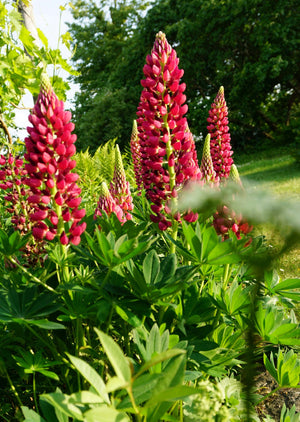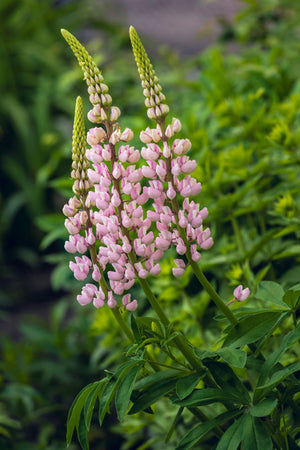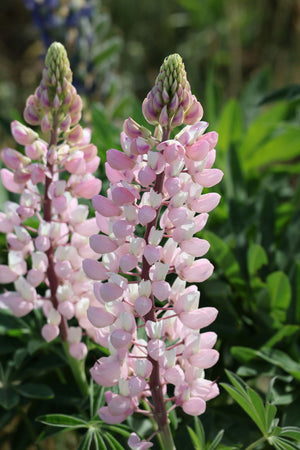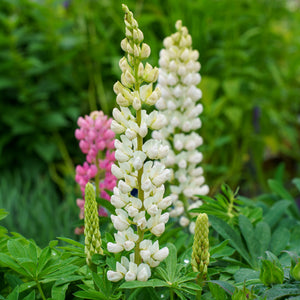The Lupinus Guide
Lupinus, commonly known as lupine, is a bold and beautiful perennial that brings dramatic vertical interest and vibrant color to garden beds and borders. Known for its tall, spiked flower clusters and palmate foliage, lupine has long been a favorite of cottage gardeners and pollinators alike. With a wide range of cultivars and color blends, including classic blue, pink, red, yellow, and bicolor forms, lupines deliver a striking early-to-mid-summer display.

About
Lupines belong to the Fabaceae (legume) family and are native to North and South America, as well as parts of the Mediterranean. Most ornamental lupines grown in gardens are hybrids of Lupinus polyphyllus, admired for their tall spires and lush, divided foliage.
Modern series like the Gallery, Mini Gallery, and Westcountry collections offer improved uniformity, richer colors, and stronger stems:
- The Gallery Series includes 'Gallery Blue', 'Gallery Pink', 'Gallery Yellow', and 'Gallery Red', ideal for compact borders.
- The Mini Gallery line, such as 'Blue Bicolor' and 'Mini Gallery Pink', stays short and bushy—perfect for containers and small gardens.
- The Westcountry series includes standout selections like 'Desert Sun', 'Manhattan Lights', 'Masterpiece', 'Persian Slipper', and 'Tequila Flame', known for bold bicolors and robust growth.
In addition to their striking appearance, lupines improve soil health by fixing atmospheric nitrogen in the soil through their root nodules.

PLANTING
Lupines are best planted in well-drained, moderately fertile soils and require attention to placement and conditions to ensure long-term success:
- USDA Hardiness Zones: Hardy in Zones 4–8.
- Soil: Well-drained, slightly acidic to neutral soil. Avoid rich soils or heavy fertilization, which can reduce flowering.
- Sunlight: Full sun is preferred, though in hotter climates, some afternoon shade helps preserve bloom quality.
- Spacing: Space plants 12–18 inches apart to allow for mature clump development.
- Planting Time: Sow seeds in fall or early spring, or transplant container-grown plants in spring after frost.
For seed-grown lupines, scarifying the seed coat and soaking overnight in warm water can improve germination. Young plants develop a deep taproot and do not transplant well once established.

CARE
With proper conditions, lupines are low-maintenance and rewarding, though they benefit from a few regular care practices:
- Watering: Keep soil evenly moist during active growth, especially in dry spring conditions. Avoid waterlogged soil.
- Fertilizing: Lightly fertilize with a balanced, low-nitrogen formula in early spring if needed. Overfeeding leads to lush foliage but fewer blooms.
- Deadheading: Remove spent flower spikes to encourage a second flush of blooms and prolong flowering.
- Staking: Taller cultivars like those in the Westcountry series may benefit from staking in windy or exposed locations.
- Dividing: Lupines don’t respond well to division due to their deep taproots. Instead, propagate from seed or basal cuttings in early spring.
Mulch lightly to suppress weeds and retain moisture but keep mulch away from the crown to prevent rot.

HOW TO USE
Lupines offer dramatic texture and color in both traditional and modern garden settings. Their vertical form and early bloom time make them excellent focal points in mixed plantings:
- Cottage Gardens: Mix with delphinium, foxglove, or campanula for a layered, old-fashioned look.
- Borders & Backdrops: Use tall varieties like 'Rachel de Thame', 'Red Rum', or 'Salmon Star' at the back of borders.
- Pollinator Gardens: Lupines are rich in nectar and attract bees, butterflies, and hummingbirds.
- Cut Flower Gardens: The long stems and vivid blooms are excellent for fresh arrangements.
- Containers: Dwarf varieties like Mini Gallery Yellow or Noble Maiden can add structure and color to large patio pots.
For visual impact, group lupines in clusters of 3 or more and pair with contrasting textures like ornamental grasses or rounded perennials like peonies.

COMMON QUESTIONS
- What is Lupinus? Lupinus is the botanical name for lupine, a nitrogen-fixing flowering perennial known for its tall, spiked blooms.
- How to plant Lupinus? Plant in full sun with well-drained soil. Space 12–18 inches apart and water regularly during establishment.
- How to grow Lupinus? Start from seed or transplants in spring. Provide regular water, avoid excess nitrogen, and deadhead to extend flowering.
- How to care for Lupinus? Water deeply but infrequently, prune faded flowers, and stake tall types as needed. Avoid moving mature plants due to deep roots.
- How big do Lupinus grow? Heights range from 12 inches (Mini Gallery) to 3–4 feet (Westcountry series and tall hybrids).
- Do deer eat Lupinus? Lupines are typically deer resistant due to their alkaloid content.
- Are Lupinus toxic to cats? Yes, all parts of lupine contain alkaloids and may be toxic to cats if ingested.
- Are Lupinus toxic to dogs? Yes, lupines are considered toxic to dogs and may cause gastrointestinal upset or more serious symptoms.
- Do rabbits eat Lupinus? Lupines are usually avoided by rabbits due to their bitter compounds.
Conclusion
Lupines are one of the most eye-catching perennials for early summer gardens. Their vertical habit, nitrogen-fixing ability, and spectrum of rich colors make them both beautiful and beneficial additions to beds and borders. With cultivars suited for every scale—from compact containers to dramatic backdrops—lupines offer gardeners an easy way to elevate their landscape with texture and pollinator power.
The Lupinus Collection
Sold Out
Sold Out
Sold Out
Sold Out






